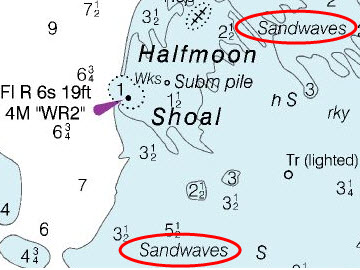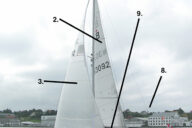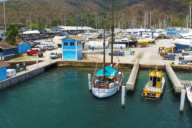Captain John of skippertips.com explains how to steer clear of three submerged dangers.
What powerful dangers could grab hold of your steering like the tentacles of a giant squid? Or lie in wait just beneath the surface to cause you to ground on a sandy shoal? Enjoy this exclusive excerpt from the new eBook “Chart Symbols Made Easy”.

1. Look for Hidden Waves Beneath the Surface!
Note the sandwaves abbreviation to the south and northeast of Halfmoon Shoal light on this chart in the Florida Keys. These sandwaves are located in a dangerous reef called “The Quicksands”.
Sand waves are dynamic bottom waves of sand generated in tidal areas. They look similar to surface waves and can have wavelengths hundreds of meters long.
One study states that sand waves can reach heights of one to five meters. These phenomena can decrease the amount of navigable water in an area.
Scan shallow waters for this abbreviation or the wavy lines that accompany the abbreviation (northernmost sandwaves in the illustration to the right). Keep clear to avoid grounding and serious damage to your keel, rudder, shaft or propeller.

I believe few things in boating are as disconcerting as loss of rudder control. Lose control of steering on a twin-screw boat or ship, and you still have some control over the vessel. You can “steer” with the engines.
Lose control aboard a single screw power or sail boat and you will have your hands full–and even more so in swift currents.
Tide rips and eddies can cause “mini whirlpools” on the surface. These could overwhelm small vessels and lead to loss of control and grounding.
In the illustration, note the small circular “Eddies” symbols and abbreviation to the southeast of Sail Rock. Highlight these dangers on your nautical or electronic chart. Set your GPS alarm to trigger if you sail too close.

3. Don’t Let Riprap Ruin Your Day!
Lighthouses welcome mariners to harbors, guide them along the seacoast, and provide position “fixes” along the intended path inside big bays and rivers. But you need to avoid sailing too close to those that show a squiggly boundary that surrounds the black dot (note the riprap symbol of a squiggly circle at RACE ROCK LT).
This indicates stones, slate, or similar foundation material has been placed around the base of the light structure to fight erosion. Some lights are exposed to waves in all weather. Without the addition of riprap, the light’s main structure could be damaged.
But sailors beware; at higher tidal stages, riprap can hide beneath the waves. And, riprap material can move after a big storm or storm surge. Steer clear to avoid “keel contact” with deadly riprap!
~~~~~~~~~~~~~~~~~~~~
Keep your small sailboat in safe water when you know the most vital nautical chart symbols for sailing safety. Sail with confidence this sailing season–wherever in the world you choose to sail or cruise!











